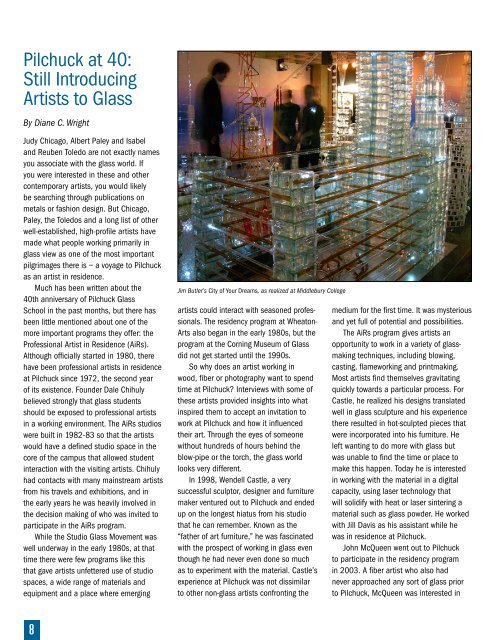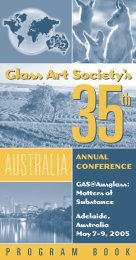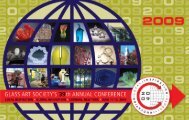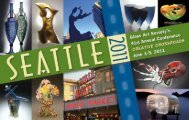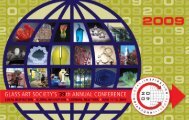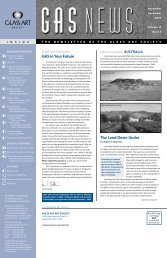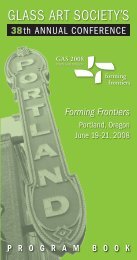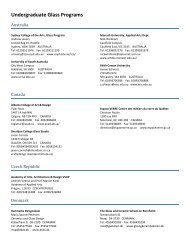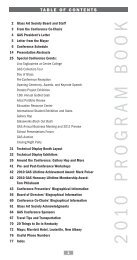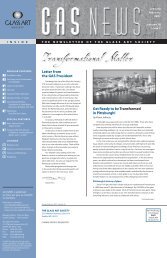GASNews October/ November 2011 Volume 22 ... - Glass Art Society
GASNews October/ November 2011 Volume 22 ... - Glass Art Society
GASNews October/ November 2011 Volume 22 ... - Glass Art Society
Create successful ePaper yourself
Turn your PDF publications into a flip-book with our unique Google optimized e-Paper software.
Pilchuck at 40:<br />
Still Introducing<br />
<strong>Art</strong>ists to <strong>Glass</strong><br />
By Diane C. Wright<br />
Judy Chicago, Albert Paley and Isabel<br />
and Reuben Toledo are not exactly names<br />
you associate with the glass world. If<br />
you were interested in these and other<br />
contemporary artists, you would likely<br />
be searching through publications on<br />
metals or fashion design. But Chicago,<br />
Paley, the Toledos and a long list of other<br />
well-established, high-profile artists have<br />
made what people working primarily in<br />
glass view as one of the most important<br />
pilgrimages there is – a voyage to Pilchuck<br />
as an artist in residence.<br />
Much has been written about the<br />
40th anniversary of Pilchuck <strong>Glass</strong><br />
School in the past months, but there has<br />
been little mentioned about one of the<br />
more important programs they offer: the<br />
Professional <strong>Art</strong>ist in Residence (AiRs).<br />
Although officially started in 1980, there<br />
have been professional artists in residence<br />
at Pilchuck since 1972, the second year<br />
of its existence. Founder Dale Chihuly<br />
believed strongly that glass students<br />
should be exposed to professional artists<br />
in a working environment. The AiRs studios<br />
were built in 1982-83 so that the artists<br />
would have a defined studio space in the<br />
core of the campus that allowed student<br />
interaction with the visiting artists. Chihuly<br />
had contacts with many mainstream artists<br />
from his travels and exhibitions, and in<br />
the early years he was heavily involved in<br />
the decision making of who was invited to<br />
participate in the AiRs program.<br />
While the Studio <strong>Glass</strong> Movement was<br />
well underway in the early 1980s, at that<br />
time there were few programs like this<br />
that gave artists unfettered use of studio<br />
spaces, a wide range of materials and<br />
equipment and a place where emerging<br />
Jim Butler’s City of Your Dreams, as realized at Middlebury College<br />
artists could interact with seasoned professionals.<br />
The residency program at Wheaton-<br />
<strong>Art</strong>s also began in the early 1980s, but the<br />
program at the Corning Museum of <strong>Glass</strong><br />
did not get started until the 1990s.<br />
So why does an artist working in<br />
wood, fiber or photography want to spend<br />
time at Pilchuck? Interviews with some of<br />
these artists provided insights into what<br />
inspired them to accept an invitation to<br />
work at Pilchuck and how it influenced<br />
their art. Through the eyes of someone<br />
without hundreds of hours behind the<br />
blow-pipe or the torch, the glass world<br />
looks very different.<br />
In 1998, Wendell Castle, a very<br />
successful sculptor, designer and furniture<br />
maker ventured out to Pilchuck and ended<br />
up on the longest hiatus from his studio<br />
that he can remember. Known as the<br />
“father of art furniture,” he was fascinated<br />
with the prospect of working in glass even<br />
though he had never even done so much<br />
as to experiment with the material. Castle’s<br />
experience at Pilchuck was not dissimilar<br />
to other non-glass artists confronting the<br />
medium for the first time. It was mysterious<br />
and yet full of potential and possibilities.<br />
The AiRs program gives artists an<br />
opportunity to work in a variety of glassmaking<br />
techniques, including blowing,<br />
casting, flameworking and printmaking.<br />
Most artists find themselves gravitating<br />
quickly towards a particular process. For<br />
Castle, he realized his designs translated<br />
well in glass sculpture and his experience<br />
there resulted in hot-sculpted pieces that<br />
were incorporated into his furniture. He<br />
left wanting to do more with glass but<br />
was unable to find the time or place to<br />
make this happen. Today he is interested<br />
in working with the material in a digital<br />
capacity, using laser technology that<br />
will solidify with heat or laser sintering a<br />
material such as glass powder. He worked<br />
with Jill Davis as his assistant while he<br />
was in residence at Pilchuck.<br />
John McQueen went out to Pilchuck<br />
to participate in the residency program<br />
in 2003. A fiber artist who also had<br />
never approached any sort of glass prior<br />
to Pilchuck, McQueen was interested in<br />
8


